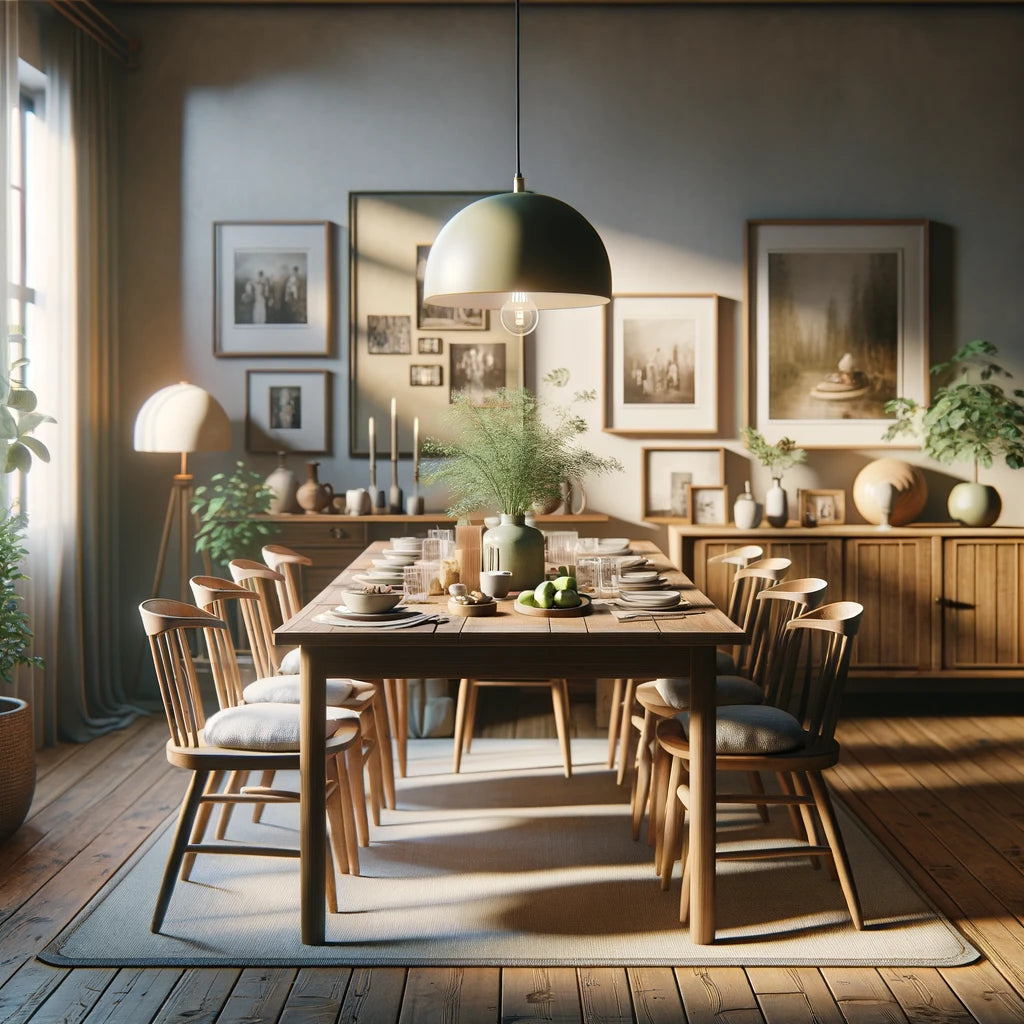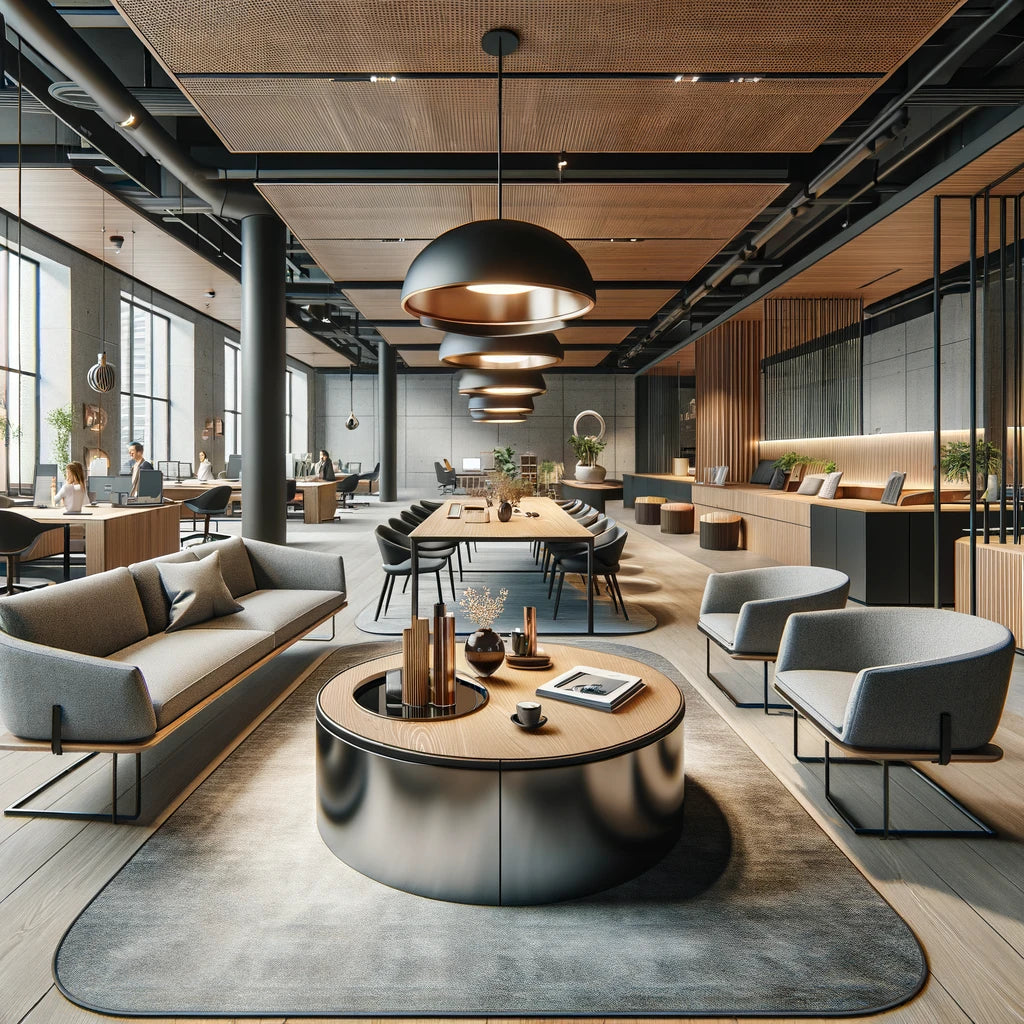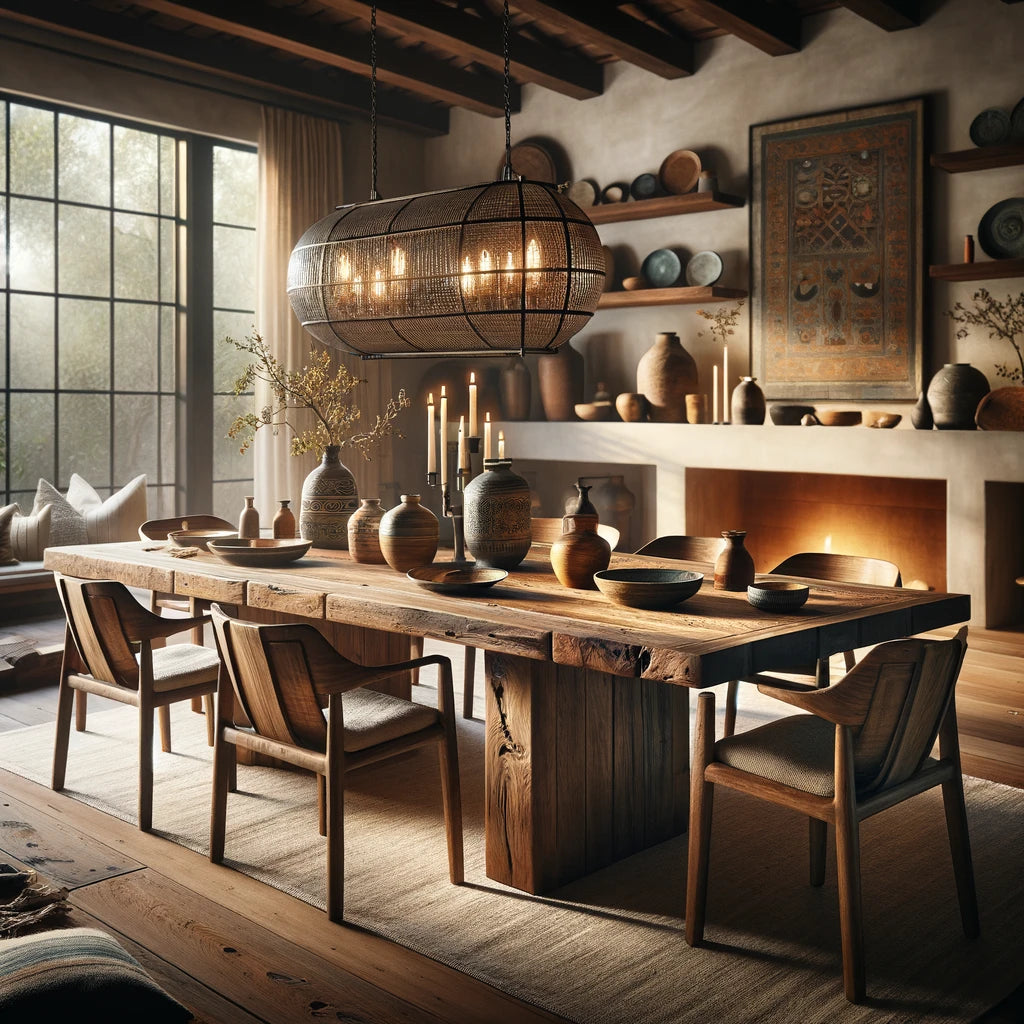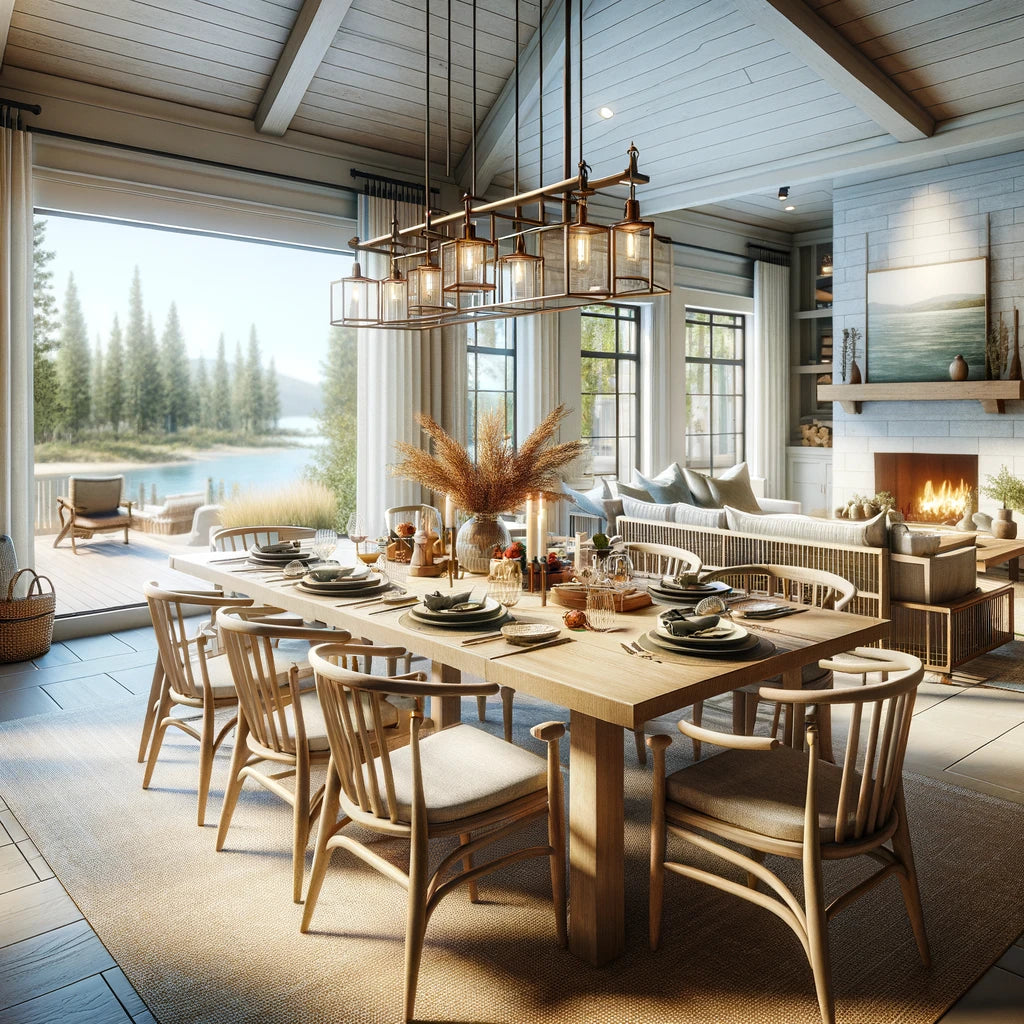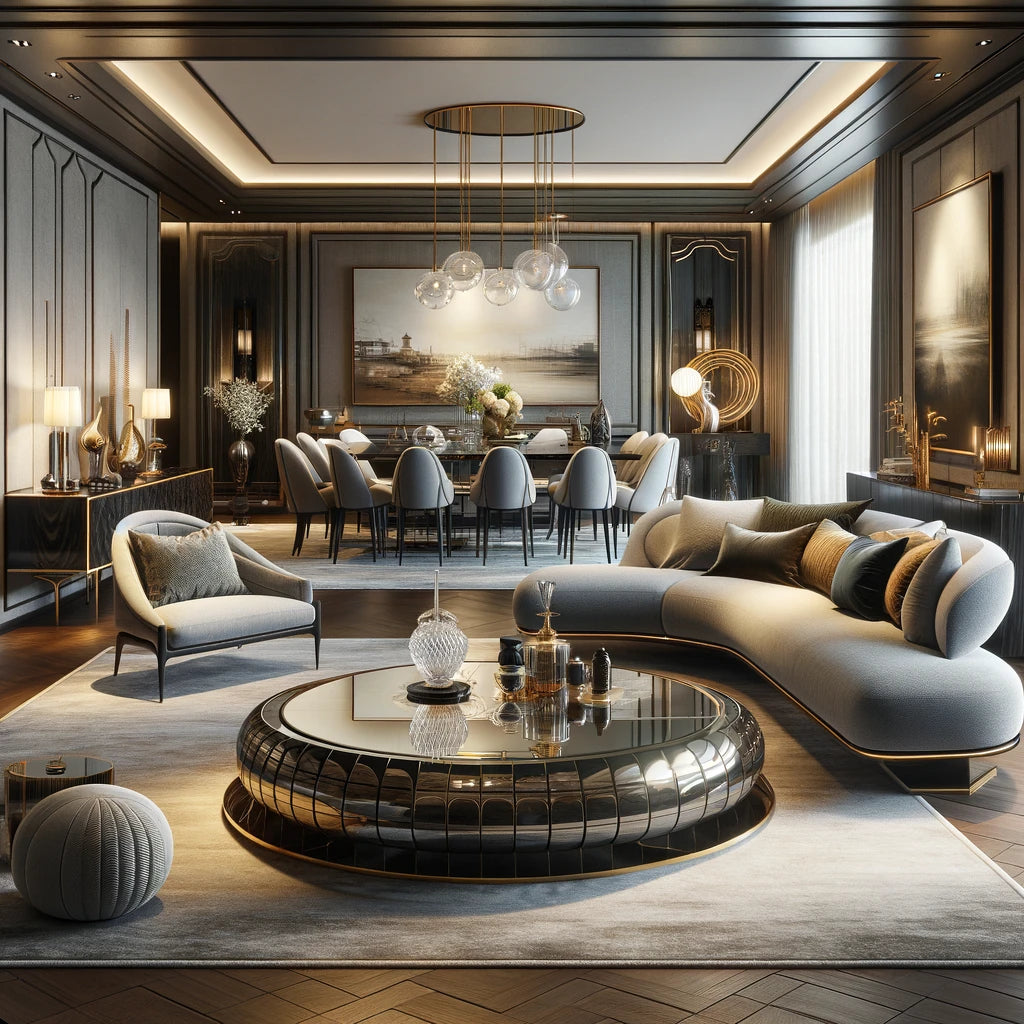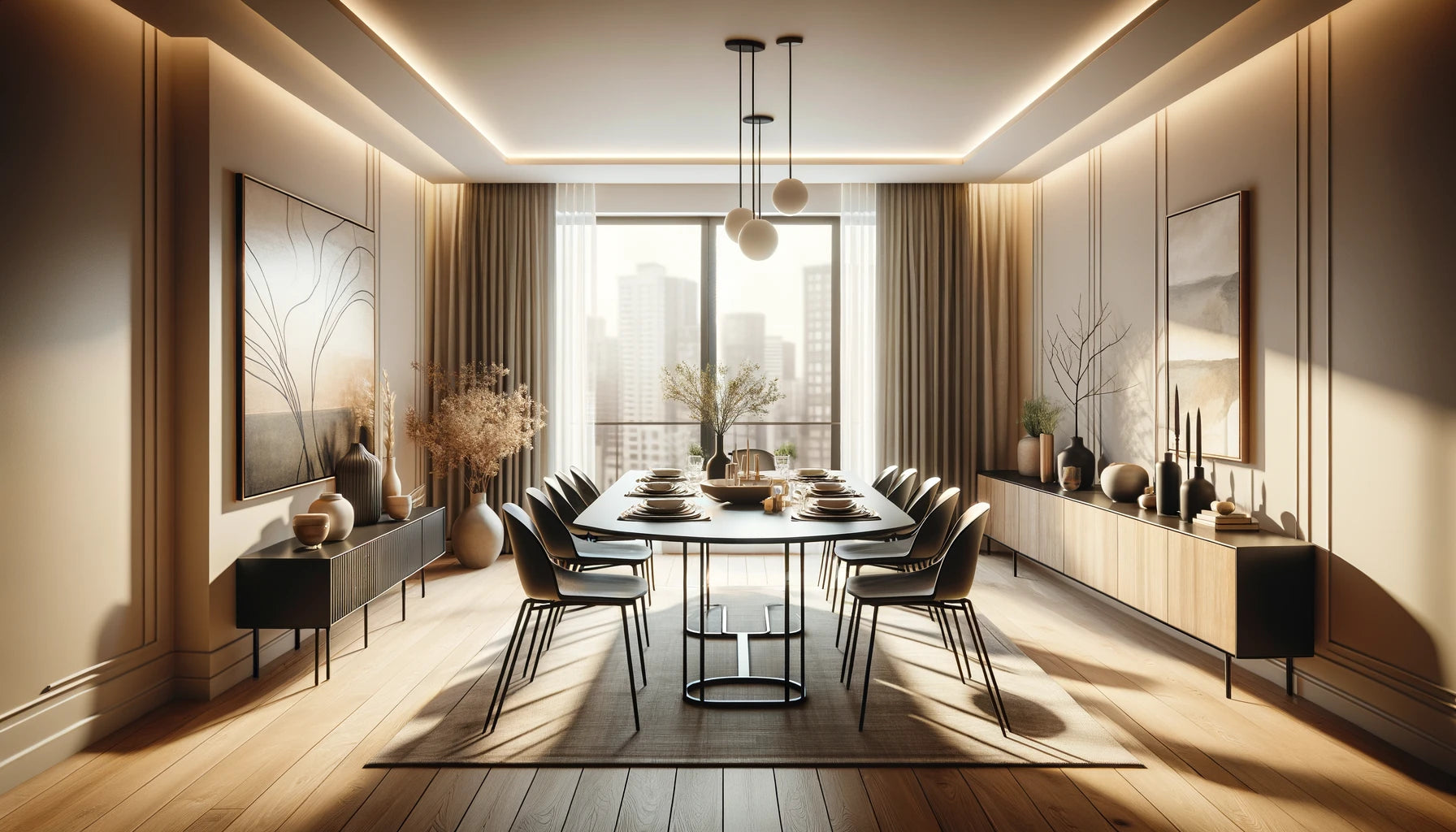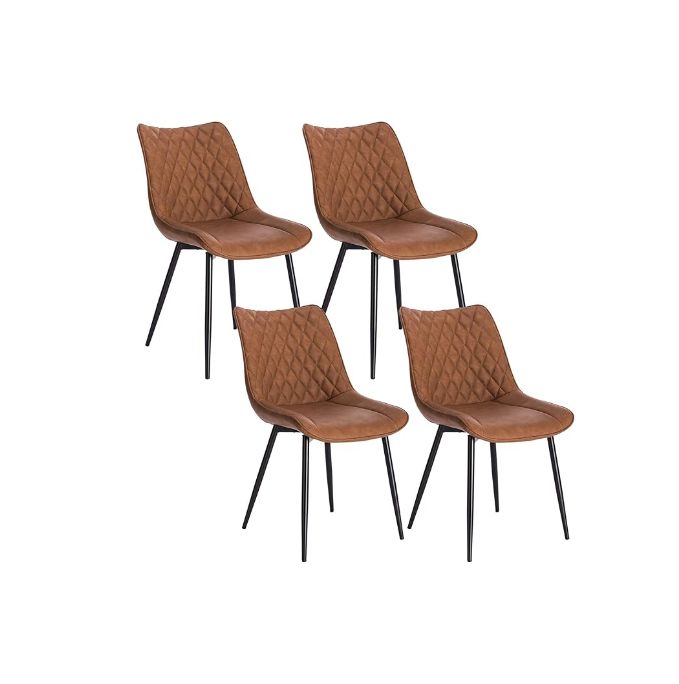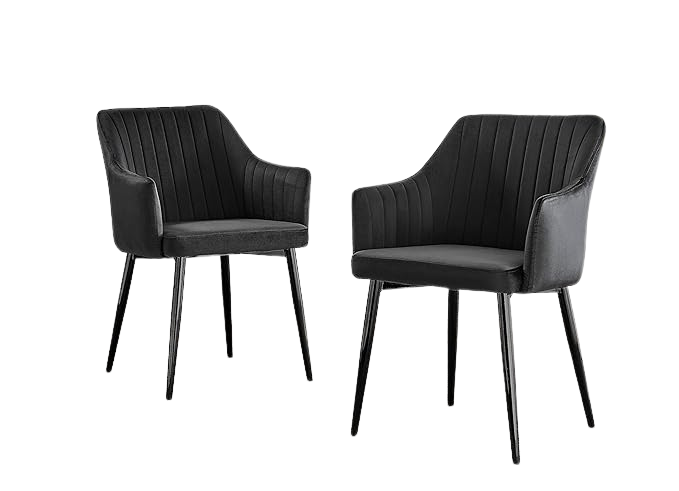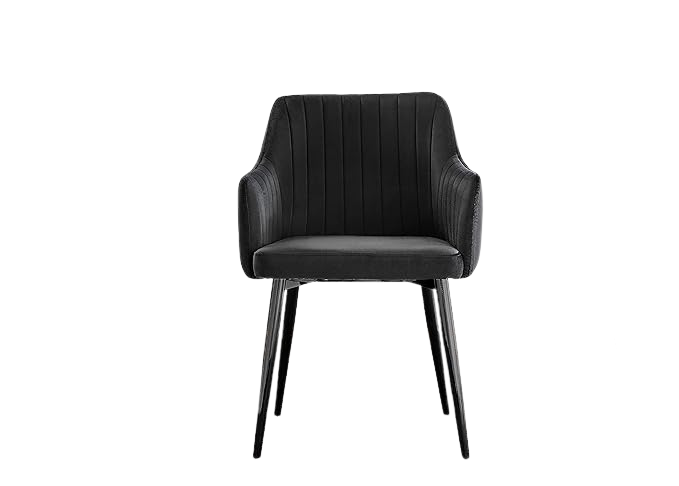In the world of interior design, dining spaces hold a special place as the heart of a home.
It's where we gather with loved ones to share meals, stories, and create lasting memories. The choice of dining table and its design plays a pivotal role in shaping the ambiance of this cherished space.
In this exploration of textures and materials, we delve into the art of weaving warmth and modernity into dining areas, each element chosen thoughtfully to create an atmosphere that resonates with your personal style and complements your interior décor.
The Warm Embrace of Wood
Wooden furniture has been a beloved choice for centuries, and its enduring popularity is a testament to its timeless appeal.
The warmth and natural charm of wood have a way of transcending trends and styles, making it a perennial favourite in the world of interior design. Whether it's the comforting embrace of an antique oak dining table or the contemporary elegance of a sleek walnut piece, wood has a unique ability to transform any space it graces.
One of the most captivating features of wood is its grain patterns. Each piece of wood carries its own distinct markings, resulting in a one-of-a-kind masterpiece with every furniture creation. These intricate patterns tell a story of the tree's growth, with knots, whorls, and lines revealing its history. Running your fingers along the surface of a wooden dining table allows you to connect with nature in a tangible way, fostering a sense of harmony and tranquillity in your home.

The tactile experience of wood is a sensory delight. Whether it's the gentle smoothness of maple, the robust and sturdy character of oak, or the rich, deep hues of walnut, wood engages our senses in a way that no other material can. It's not just a piece of furniture; it's a living, breathing part of your home. The warmth and depth of wood evoke a feeling of comfort and cosiness, turning your dining area into a haven of relaxation and conviviality.
Furthermore, wood's versatility is a key factor in its enduring popularity. Different types of wood offer an array of textures and colours, allowing for a diverse range of design options. If you desire a rustic ambiance, opt for reclaimed barn wood with its weathered charm. For a more refined and elegant setting, a beautifully finished cherry or mahogany table will be your ideal choice. The possibilities are endless, ensuring that wood can effortlessly fit into any interior design style, from classic to contemporary.

Beyond its aesthetic appeal, wood has the remarkable ability to ground and centre a dining room. The warmth exuded by a wooden table not only adds character to the space but also creates a focal point that draws people together. Whether you're hosting a festive family gathering or an intimate dinner for two, the wooden table becomes the heart of your dining area, inviting conversation and connection.

In a world filled with mass-produced furniture and synthetic materials, the warm embrace of wood stands as a testament to the enduring beauty of nature's creations. Its timelessness, unique grain patterns, and tactile allure continue to make it the perfect choice for those seeking a sense of authenticity and comfort in their homes. So, whether you are furnishing a new dining room or looking to refresh your existing one, consider the enduring charm of wood, and let its natural beauty infuse your space with warmth and character.
The Sleek Touch of Metal
In contrast to the warm embrace of wood, the introduction of metal into your dining space brings forth a sleek and modern vibe that instantly transforms the ambiance.

Metal is a material of choice for those seeking to infuse their interior design with contemporary flair and minimalist sophistication. Its smooth and often reflective surface captivates the eye, creating a striking contrast to the organic charm of wood.
The versatility of metal is one of its key strengths in the world of furniture design. It can be used in a variety of ways, allowing for endless creative possibilities. A dining table crafted entirely from metal exudes a sense of unapologetic modernity, embracing clean lines and a minimalist aesthetic. The seamless, monolithic design can be a striking centrepiece in a space dedicated to modernity and simplicity, creating an atmosphere of refined elegance.
Alternatively, metal can also serve as a structural framework for other materials, such as glass or wood. This combination results in a fusion of textures and aesthetics, where the cool touch of metal plays the role of the elegant anchor. For instance, a glass tabletop supported by a sleek metal base creates an illusion of lightness and transparency, making your dining area feel more spacious and airy.
Metal accents, whether in the form of table legs, chair frames, or decorative elements, can add an industrial edge to your dining space. This juxtaposition of the raw and the refined creates a captivating atmosphere, where the cool, hard lines of metal harmonise with the warmth of other materials. The blend of wood and metal, for example, combines the best of both worlds – the organic charm of wood and the modern allure of metal – resulting in a harmonious dining experience that is both inviting and chic.

Moreover, metal's ability to reflect light can make your dining area feel brighter and more vibrant, enhancing the overall atmosphere. The interplay of light and metal creates dynamic visual effects, adding depth and dimension to your space. Whether it's the gleam of polished stainless steel or the matte finish of brushed aluminium, metal contributes to a sense of opulence and refinement.

The Role of Texture in Design
Texture is a multifaceted element that extends its influence well beyond the realm of tactile sensation; it exerts a substantial visual impact on the overall design of a dining space.
The way a table's texture is perceived can shape the entire atmosphere of the area, evoking emotions that span the spectrum from cosy and casual to elegant and formal. The artful combination and interplay of various textures, such as the rugged charm of wood grain juxtaposed with the sleekness of metal, contribute to a captivating visual landscape that adds depth and interest to the design.

When it comes to interior design, texture is a powerful tool. It engages our senses and stimulates our perception of a space. Imagine running your hand across the rough, weathered surface of a reclaimed wood dining table. The tactile experience alone can transport you to a rustic, countryside setting, fostering a sense of warmth and nostalgia. In contrast, the cool, smooth touch of a polished marble tabletop instantly communicates sophistication and elegance, inviting diners to partake in a refined experience.
Beyond the tactile sensations, texture influences our visual perception. A table's texture can set the tone for the entire dining area. For instance, a distressed wood table, with its natural imperfections and tactile allure, is perfectly suited for creating a cosy and informal ambiance. It imparts a sense of lived-in comfort, encouraging guests to relax and unwind in a welcoming atmosphere.
On the other hand, the marriage of textures can be a design masterpiece in itself. Combining the rugged texture of a wood tabletop with the sleek, reflective surface of metal legs results in a harmonious blend of contrasting elements. This juxtaposition adds visual interest, creating a dynamic focal point that draws the eye. The rough-meets-smooth combination infuses the dining area with character and depth, making it a space that is not only inviting but also visually stimulating.
Texture can also be manipulated to evoke specific moods and styles. A table adorned with a textured, intricately patterned tablecloth or placemats adds a layer of visual interest and a touch of formality to the setting, creating an ambiance suitable for special occasions and formal gatherings. Conversely, the choice of smooth, minimalist tableware against a sleek, modern table surface conveys a sense of contemporary chic and simplicity.

Personalisation Through Material Choice
The beauty of modern table design extends to the realm of customisation, where the choices in texture and material provide a canvas for expressing one's unique taste and personality.
In today's diverse design landscape, the possibilities are virtually endless, allowing individuals to curate dining experiences that are a true reflection of their personal style while seamlessly complementing their interior décor.

Material choice is a pivotal aspect of personalisation in table design. It's akin to selecting the right brushstrokes for a masterpiece, with each material offering its distinct aesthetic and character. For those who revel in the organic and grounding qualities of nature, the selection of a solid wood table serves as a testament to their appreciation for the natural world. Whether it's the warm, honeyed tones of oak or the rich, dark allure of walnut, wood choices resonate with an earthy feel that creates a comforting and inviting dining atmosphere. The unique grain patterns of each wood type provide a touch of individuality, making every table as unique as its owner.
Conversely, those with a penchant for the sleek, minimalist aesthetic find their muse in metal. Opting for a metal table is a declaration of an affinity for clean lines, modernity, and an industrial edge. The reflective surfaces of metals like stainless steel or the matte finish of brushed aluminium make a bold statement, adding an element of sophistication to the dining space. Such choices convey an appreciation for the art of simplicity and a preference for a contemporary ambiance.
Furthermore, personalisation goes beyond just the choice of primary material. It extends to the interplay of materials within the design. The fusion of wood and metal, for example, allows individuals to strike a harmonious balance between the warmth of nature and the coolness of modernity. This juxtaposition of contrasting elements not only reflects a multifaceted personality but also creates a dynamic visual appeal that adds depth to the dining experience.

In essence, personalisation through material choice in modern table design empowers individuals to craft a dining area that is a true reflection of their unique tastes and preferences. Whether you lean towards the natural, earthy feel of wood or the sleek, industrial allure of metal, your choice becomes an extension of your personality, enhancing the overall ambiance and aesthetics of your home. With such a wide array of options available, the modern dining table becomes a canvas on which you can paint your own design narrative, creating a space that resonates with your individuality and elevates your dining experiences to new heights of personal satisfaction.
Concluding Remarks
As we draw our journey through textures and tables to a close, it becomes evident that the choices we make in furniture design extend far beyond mere aesthetics. Whether you find solace in the warm embrace of wood, embrace the sleek touch of metal, appreciate the interplay of contrasting textures, or revel in the personalisation offered by various materials, your dining space becomes a reflection of your unique personality and style.
In the realm of interior design, dining areas are not just places to enjoy a meal; they are sanctuaries of comfort, spaces that foster connection and togetherness. The dining table, with its textures and materials, serves as the centrepiece of this cherished domain, setting the stage for countless moments of laughter, joy, and shared experiences.
In the end, it's not just about the table; it's about creating an environment where you can savour life's moments, bask in the beauty of your surroundings, and feel truly at home. So, whether your heart gravitates towards the rustic allure of wood, the modern sophistication of metal, or the harmonious blend of textures, let your dining space be a reflection of your personality and a sanctuary where memories are made.



